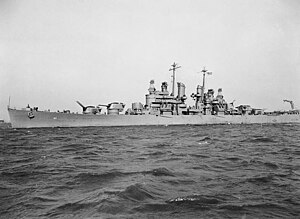 USS Montpelier (CL-57) in Dec 1942 USS Montpelier (CL-57) in Dec 1942
| |
| History | |
|---|---|
| Name | Montpelier |
| Namesake | City of Montpelier, Vermont |
| Builder | New York Shipbuilding Corporation, Camden, New Jersey |
| Laid down | 2 December 1940 |
| Launched | 12 February 1942 |
| Sponsored by | Mrs. William F. Carry |
| Commissioned | 9 September 1942 |
| Decommissioned | 24 January 1947 |
| Stricken | 1 March 1959 |
| Identification |
|
| Motto |
|
| Honors and awards | |
| Fate | Scrapped in 1960 |
| General characteristics | |
| Class and type | Cleveland-class Light cruiser |
| Displacement |
|
| Length | |
| Beam | 66 ft 4 in (20.22 m) |
| Draft |
|
| Installed power |
|
| Propulsion |
|
| Speed | 32.5 kn (37.4 mph; 60.2 km/h) |
| Range | 11,000 nmi (20,000 km) @ 15 kn (17 mph; 28 km/h) |
| Complement | 1,255 officers and enlisted |
| Armament |
|
| Armor |
|
| Aircraft carried | 4 × floatplanes |
| Aviation facilities | 2 × stern catapults |
| Service record | |
| Operations: | World War II |
| Awards: | 13 × Battle stars |
USS Montpelier (CL-57) was one of 27 United States Navy Cleveland-class light cruisers completed during or shortly after World War II. She was the second US Navy ship to be named for the city of Montpelier, Vermont. Montpelier was commissioned in September 1942 and saw service in several campaigns in the Pacific. Like almost all her sister ships, she was decommissioned shortly after the end of the war, and never saw active service again. Montpelier was scrapped in the early 1960s.
Construction
Montpelier was laid down on 2 December 1940 by New York Shipbuilding Corp., Camden, New Jersey; launched on 12 February 1942; sponsored by Mrs. Lesley Sayer Corry, wife of William F. Corry, mayor of Montpelier, Vermont; and commissioned on 9 September 1942, Captain Leighton Wood in command.
Service history
World War II
Montpelier arrived in Nouméa, New Caledonia on 18 January 1943 from Norfolk, Virginia Rear Admiral A. S. Merrill chose her for the flagship of Cruiser Division 12 (CruDiv 12). On 25 January, she reached Efate, New Hebrides, her home base for the next few months. While making a sweep around beleaguered Guadalcanal, she participated in the Battle of Rennell Island on 29 January, the last naval engagement of the Guadalcanal Campaign.
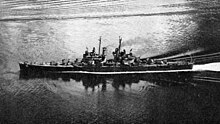
Montpelier covered the landings on the Russell Islands on 21 February. On the night of 5–6 March, she heavily bombarded the Vila‑Stanmore airfield on Kolombangara in the Solomons, and helped sink an enemy destroyer in the Battle of Blackett Strait. She and three other cruisers bombarded Poporang Island (in the Shortland Islands) on the night of 29–30 June, in preparation for the invasion of New Georgia. On the night of 11–12 July, she bombarded fortifications on Munda, enabling troops to continue their conquest of New Georgia. She patrolled the New Georgia area for the next four months to prevent Japanese troop withdrawals.
After a voyage to Sydney, Australia, she joined Task Force 39 (TF 39) as its flagship for the invasion of the Treasury and Bougainville Islands. On 1 November, Montpelier shelled the Buka‑Bonis airfields on the northern tip of Bougainville, and hit the Japanese defenses on the islands of Poporang and Balalae, in the Shortlands. TF 39, consisting of cruisers and destroyers, engaged a superior Japanese force in the Battle of Empress Augusta Bay while guarding transports on the night of 2 November. The result was a victory for the U.S. ships commanded by Admiral Merrill. The victory turned back the Japanese from what would have been a disastrous assault on the Bougainville landing forces. Besides assisting in the destruction of one ship, Montpelier's gunners shot down five enemy planes.
From 15–19 February 1944, Montpelier covered the amphibious landing on the Green Islands in the Bismarck Archipelago. In March, she hunted shipping south of Truk and participated in the invasion of the Emiraus. On 20 May 1944, Montpelier received light damage from return fire when she and two other light cruisers, along with eight destroyers, bombarded shore installations on Shortland, Poporang, and Magusaiai islands in the Shortlands. On 1 October 1944, the US Navy's Special Air Task Force (SATFOR), and began shelling Saipan on 14 June to support the Mariana Islands invasion. She joined TF 58 and participated in the decisive Battle of the Philippine Sea from 19–21 June. During the engagement, Japanese carrier air groups were virtually annihilated. Montpelier returned to the Marianas, and continued her shelling of Saipan, Tinian, and Guam. She left the Marianas on 2 August for overhauling in the United States.
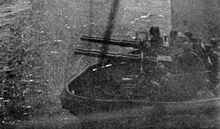
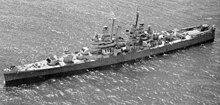

Returning on 25 November, she joined a task group off Leyte Gulf. While steaming on defensive patrol off the Gulf, Montpelier was slightly damaged by a kamikaze attack on 27 November. She fought off numerous other kamikaze attacks, shooting down four planes.
Beginning on 12 December, Montpelier provided beach cover for the invasion of Mindoro. Fighting kamikazes, she protected troops at the Lingayen Gulf landing in January 1945. In February, she supported operations off Mariveles Harbor, Corregidor, and Palawan, and from 14–23 April, she covered the landings on Mindanao. From her base at Subic Bay, she steamed to Brunei Bay, Borneo, arriving on 9 June. From 17 June to 2 July, she sailed off the oil center at Balikpapan, providing support for minesweepers, underwater demolition teams, and amphibious forces. During the latter part of July and early August, Montpelier made three anti-shipping sweeps in the East China Sea as part of Task Force 95.
Post-War
When hostilities ended, she anchored off Wakayama, Japan, and helped accelerate the evacuation of Allied prisoners. After an inspection of Japanese ships, part of her crew went ashore to view the ruins of Hiroshima. On 18 October she covered the landing of occupation forces at Matsuyama. Montpelier departed from Hiro Wan and Japanese waters on 15 November for the East Coast, having battled the enemy from their deepest point of advance to their very homeland. From the Pacific, Montpelier sailed first for Hawaii, then to San Diego, California, before heading south to pass through the Panama Canal, with her final destination being New York City.
She reported for duty with the Atlantic Fleet on 11 December, and on 1 July 1946 reported for duty with the 16th Fleet. Montpelier decommissioned and berthed in reserve at Philadelphia on 24 January 1947. She was struck from the Naval Register on 1 March 1959, and was sold for scrap to Bethlehem Steel Co. 22 January 1960.
Awards
Montpelier received 13 battle stars for World War II service, as well as the Navy Unit Commendation ribbon for outstanding heroism in action against enemy Japanese combatant ships on the night of 1–2 November 1943, the Battle of Empress Augusta Bay, as a member of Cruiser Division Twelve.
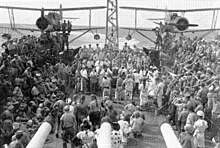
Coat of arms

Depicted:
- The Green Mountains, principal topographical feature of Vermont, for whose capital Montpelier was named.
- A crowned eagle, replica of the crest of the Empress Augusta, wife of Germany's William I, after which Empress Augusta Bay was named. Montpelier, as Flagship of Task Force 39, played the principal role in the defeat of the Japanese in the Battle of Empress Augusta Bay.
- On fringe are coral cockershells, representative of the vast expanse of the Pacific, main theater in which Montpelier operated.
Life on Montpelier
Decades after the war, James J. Fahey (1918–1991), Seaman First Class, published Pacific War Diary: 1942 - 1945, The Secret Diary of an American Sailor. The diary provides a first person account of the experience of a sailor on Montpelier throughout the war, from its first cruise from port to its final journey home. In general, keeping a diary was against Navy regulations. Thus, Fahey offered a rare view of life on Montpelier and on wartime naval life as well.
Gallery of Montpelier photographs
-
 Montpelier at launch.
Montpelier at launch.
-
 Montpelier test runs near Philadelphia.
Montpelier test runs near Philadelphia.
-
 An SOC Seagull is catapulted off Montpelier.
An SOC Seagull is catapulted off Montpelier.
-
 Montpelier underway in June 1944.
Montpelier underway in June 1944.
-
 Montpelier moored at Mare Island Navy Yard, California.
Montpelier moored at Mare Island Navy Yard, California.
-
 Montpelier wearing Camouflage Measure 32, Design 11a.
Montpelier wearing Camouflage Measure 32, Design 11a.
References
- ^ "Montpelier II (CL-57)". Naval History and Heritage Command. 11 August 2015. Retrieved 2 December 2015.
- ^ Cressman, Robert (2000). "Chapter VI: 1944". The official chronology of the U.S. Navy in World War II. Annapolis, Maryland: Naval Institute Press. ISBN 978-1-55750-149-3. OCLC 41977179. Retrieved 28 November 2007.
- Fitzpatrick, Connor (20 October 2016). "WWII Naval Drone Training". Military History of the Upper Great Lakes. Michigan Technological University. Retrieved 28 March 2020.
 This article incorporates text from the public domain Dictionary of American Naval Fighting Ships. The entry can be found here.
This article incorporates text from the public domain Dictionary of American Naval Fighting Ships. The entry can be found here.
Further reading
- Fahey, James J. (1991) . Pacific War Diary: 1942 - 1945, The Secret Diary of an American Sailor. New York: Houghton Mifflin. ISBN 0-395-64022-9. OCLC 11631185.
External links
- United States Naval Historical Center page on the Montpelier
- Homepage of Vermont's USS Montpelier Museum
- Personal Accounts from the Montpelier
- Information concerning the USS Montpelier CL-57 Association
| Cleveland-class cruisers | |
|---|---|
| Completed | |
| Converted to aircraft carriers | |
| Cancelled | |
| |